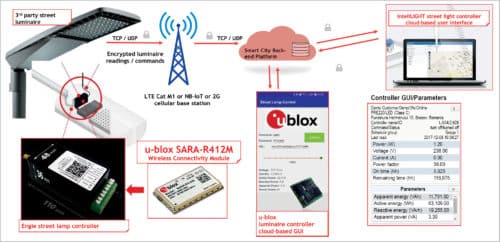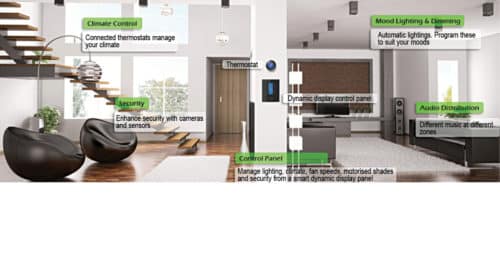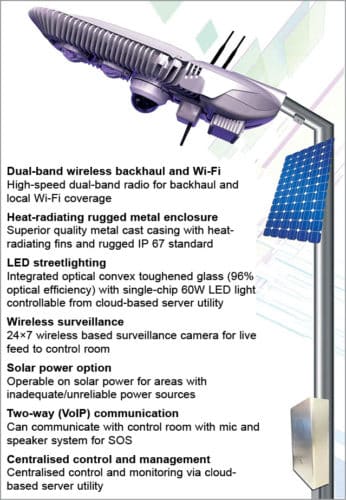Smart lighting technologies have expanded into smart cities, smart homes as well as agriculture, delivering major benefits.
Global smart city solutions based on Low Power Wide Area (LPWA) networks can significantly reduce energy consumption, carbon emissions and operational complexities. Innovations in wireless connectivity contribute to lower costs and optimum maintenance processes, with consequent benefits to the environment and municipalities’ budget. Now, streetlights too come with centrally-controlled and managed LED lights. Intensity of the lights can be increased or decreased as per needs. These smart lights can also be controlled through voice commands.
Control4 Smart Lighting features out-of-the-box voice control of lights with Amazon Alexa-enabled devices. Homes where KNX is the standard can start a music playlist with KNX keypad, adjust the heating, ventilation and air-conditioning (HVAC) system, dim or brighten the lights using a handheld remote or use voice to turn off the entire house at night from anywhere through a mobile device. The houses can be customised for automation to fit individual lifestyles.
Anuj Dhir, vice president and business head, Wipro Commercial Lighting, explains, “In modern workspaces, new technology features enable performance-tracking with real-time updates on lighting system status.” Sumit Joshi, vice chairman and managing director, Philips Lighting India, adds, “A manager can track occupancy patterns, changes in temperature, light levels and more, while employees can personalise the lighting around their desks.”
Technologies for smart streetlighting
Cellular and LPWA connectivity technologies are used in smart streetlighting. LTE Cat M1/NB1-enabled streetlighting makes cities safer and more sustainable. LPWA-connected smart city use cases include remote monitoring and predictive maintenance of streetlight networks. City planners and municipalities no longer need to design and install proprietary gateways. Using public cellular infrastructure they can avoid allocating resources and time for the operation and maintenance of proprietary communication infrastructures.
According to Diego Grassi, senior manager, product strategy cellular – IoT market development, u-blox, their smart streetlighting remote monitoring platform consists of smart street luminaires and Cat M1, NB-IoT (Internet of Things) or 2G cloud analytics platform. The streetlight controller equipped with SARA-R412M module and cellphone is used to visualise the analytics platform.

FlashNET InteliLIGHT is a backend connectivity platform with a Web-based remote monitoring graphic user interface (GUI). Wireless connectivity modules enable a plug-and-play user experience for smart city applications with the following security features:
- 3GPP global standards compliant (end-to-end connectivity and full two-way manageable channels)
- Security based on end-to-end 3GPP encryption and guaranteed quality of service (immune to interference)
- Device interoperability enabled due to use of open standard protocols
- Scalability and fast development with multiple horizontal IoT platforms
Smartlights can be used at bus stands for safety and surveillance. Wi-Fi provides Internet connectivity to devices by creating a Wi-Fi zone in that area. Cameras keep track of the arrival and departure of buses. The smartlights provide a 24×7 surveillance feed, which can prove beneficial in case of emergencies or criminal activities.
Two-way call buttons on smartlights allow connectivity to the control room or the police during emergency situations. These can also be used by people to talk to someone in the control room for any queries.
The public announcement system in smart streetlights provides a ready way to address a large number of people at a given location. It can be used to announce delays in bus timings and routes, travel distances and more, so that people can make informed decisions.
Wireless technologies to control smart lights
Motion/radar sensors can detect motion in a room, while ambient light sensors can be used to adapt the light to current conditions. Smartphones and tablets can be connected to the mesh network, enabling wireless control of lights through an app. Lights can be connected using short-range radio mesh technologies such as Bluetooth Mesh, Thread, ZigBee or other proprietary technologies like Wirepas Mesh.

Sensor data can be used as input for artificial intelligence (AI) for advanced lighting control and other smart building applications. Short-range radio mesh network can be connected to the cloud and back-end lighting control services through a cellular gateway that supports technologies like NB-IoT or LTE Cat M1.
Streetlights can be used in the same manner to form an infrastructure, where, typically, Bluetooth 5 is used to extend coverage and distance between nodes in the network.
Stefan Berggren, senior product marketing manager – product strategy short-range radio, u-blox, says, “Lights (luminaires or light bulbs) in a building are ideal for creating a cloud-connected wireless infrastructure through mesh. There are many lights in a building that could serve as nodes in a mesh network. Lights are placed in a good position on the roof where these are regularly spread and often in line-of-sight of each other. Nodes in a mesh network that route the data consume more power than end nodes. Through the mesh infrastructure, you can wirelessly control lights, that is, turn these on and off and control their dimming, light temperature and colour.
“Besides connecting actual lights, a huge number of sensors, light switches and displays can be connected to the mesh network. These nodes are typically battery-operated or operated through energy harvesting, and consume very little power. Lights can also be used as beacons for positioning and advertising services.”

Innovations in design technologies
Sambit Sengupta, associate director – field applications, Avnet India, says, “With the advent of smart homes, smart parking systems and smart buildings, there is a huge thrust given to design-connected lighting. Mood lighting, health-enhancing lighting or optimum products for horticulture all require specialised designs. Graphene and violet LED technologies are contributing to newer and efficient designs and controls. Lighting with Bluetooth Low Energy (BLE) and self-healing networks is becoming commonplace.”
Steve Roberts, technical director, RECOM Power GmbH, adds, “To future-proof lighting systems, designers are now incorporating multiple-format wireless controllers that can handle several different protocols. This is helped by firmware innovations such as DotDot from Zigbee Alliance that makes the application layer (bits you program to make the light do what you want) independent of radio and networking stacks (bits that handle communication).
“Also, the traditional boundary between wireless and wired control systems is disappearing with hybrid installations. For example, DALI Wireless allows designers to create wired zones that are wirelessly interlinked. Low-power AC-to-DC and DC-to-DC power supplies are suitable for powering always-on radio mesh nodes.”
Mohit Kumar Chauhan, manager – pre-sales, Maksat Technologies, says, “Our solution for surveillance, Wi-Fi hotspot data networks, environmental sensor data and manageable smart LED lighting requirements is a three-in-one unit with module-based functionalities. The system can be deployed along the streets or lanes in villages, for creating a hotspot mesh network for both data access and remote surveillance. It encompasses a 360-degree pan-tilt-zoom camera for surveillance, where all functionalities are fully-managed and controlled remotely by controller unit IP-based Web GUI. It has advanced features such as map display interface for marking locations of all lights in a network over digital maps.”
Technologies to enhance lighting performance
As LEDs become more efficient, performance of a luminaire is judged not just based on light output in lumens, but also the quality of light it emits. Innovations such as tunable liquid lenses have helped create luminaires where beam pattern, focus and colour temperature are adjustable.
GaN substrate LEDs now offer full spectrum output so that the colours are not just mixes of monochromatic RGB LEDs. This allows even more human-centric natural lighting for better productivity during the day and improved sleep quality at night.
Control electronics is improving, too. Low power control gear is now being fitted with power factor correction, higher full-load efficiency and reduced standby consumption. These advances are needed to reduce the lighting load in large buildings by mixing natural and artificial lights for the highest efficiency without harming the environment.
The smart streetlighting system by Maksat Technologies provides streetlight monitoring and management, image monitoring and sensing, and data transmission. ZigBee technology is used to collect data to achieve multi-node low data transmission. It also has environmental sensors that can detect temperature, humidity, carbon dioxide, carbon monoxide, air quality, air pressure and so on. Each streetlight contains a single light control unit and data collect unit attached to the lamp pole. The remote unit gateway is responsible for managing the light and data controls units. One remote unit gateway can manage up to 200 light control and 50 data control units.
Every day new technologies are coming up to enhance the performance of lighting. Organic LEDs are being developed continuously as an alternative to existing LEDs. These are as efficient as high intensity discharge lightings.
Technologies like task optimum/ambient lighting and distribution system lighting, motion sensor/passive infrared motion sensing-based lighting are revolutionising the world of lighting. Avnet India has developed a cost-optimum ceiling and wall-mounted PIR motion sensor that can detect motion accurately and automatically switch the lights on/off as per motion detection and visibility. Its supporting features are true motion detection, automatic load on/off, on/off time setting, ambient light sensor and indicating load LED.
Role of lighting in creating a controlled environment for farming
LEDs are slowly being used to control optimum lighting conditions for smart farming. There are technologies like violet LEDs and smart sensors that are helping achieve this. Avnet supports solutions for innovative lighting technologies within the plant-lighting spectrum. In advanced farming technology, plants only use red and blue wavelengths for photosynthesis. Tuned red/blue LED lighting can accelerate crop growth by up to 50 per cent. However, for harvesting, white light is also needed.
Smart agricultural lights with red, deep-blue and white LEDs are becoming standard in many industrial greenhouses. Light spectrum can be adjusted based on the type of crop (flowers, vegetables, etc). Farming is a special case where AI can be used for tuning lighting and watering systems for optimised harvest using data from humidity and ambient light sensors combined with weather reports.
Prashant Deshmukh, business head lighting – Millennium Semiconductors, says, “Innovations in lighting for indoors and outdoors have different technological requirements. Every designer follows different protocols based on the technology used. Sensors play an important role in achieving controlled and enhanced performance of lightings.”
Threats and areas of security
An important aspect of security is how easily a system can be provisioned and managed. It must be easy to deploy a network from start and then to further maintain this network by adding and removing nodes.
System designers need to follow a set of security principles to protect data and ensure secure data transmission. Any exposed interfaces in applications can be used as attack surfaces and cause harm. In firmware attacks, altered code can modify system behaviour or grant access to sensitive information.
Pointers that need to be kept in mind to achieve safe lighting controls are:
Secure firmware updates
Only authenticated and validated updates can be applied.
Secure physical interfaces and APIs
Data is integrity-protected and authenticated into and out from the module.
Each access grant to gain debug access to a device is unique.
Only authorised usage of APIs is possible as development back doors are blocked.
Robustness spoofing/jamming detection and active countermeasures
Detection of potential attacks on air interfaces is essential.
Secure transport layer
Communication with the server is authenticated and encrypted.
Latest protocols
Bluetooth 5 and Bluetooth Mesh are the new standards coming from Bluetooth SIG.
Self-healing and self-forming ZigBee IEEE 802.15.4, IEEE 802.11 AC Wi-Fi mesh are the standards for Wi-Fi.
DALI, although old, is currently being revamped to bring DALI 2 standard into the modern area.





